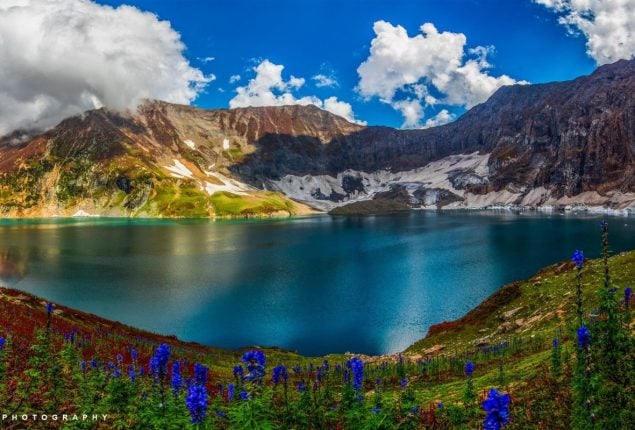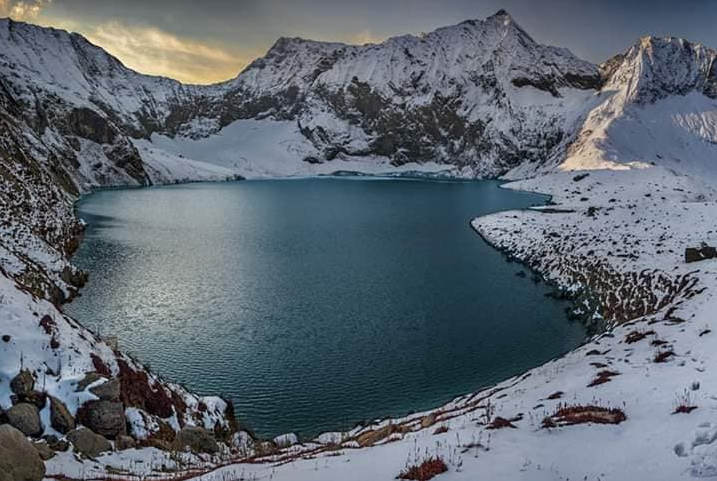Introduction to Ratti Gali Lake
Situated in the Azad Kashmir region of Pakistan, Ratti Gali Lake is a stunning alpine glacial lake renowned for its breathtaking beauty and serene environment. This lake, situated at an elevation of approximately 12,130 feet (3,700 meters), is surrounded by lush green meadows, towering mountains, and a rich variety of flora and fauna. Understanding the weather conditions of Ratti Gali Lake is essential for planning a successful visit. In this article, we will provide a detailed analysis of the weather patterns, seasonal variations, and tips for travelers.

Ratti Gali Lake Weather Overview Throughout the Year
Spring (March to May)
Spring is a transitional period in Ratti Gali Lake, marked by gradually warming temperatures and melting snow. During this season:
- Temperatures: Daytime temperatures range from 10°C to 15°C (50°F to 59°F), while nighttime temperatures can drop to around -5°C to 0°C (23°F to 32°F).
- Weather Conditions: The weather is generally pleasant during the day with clear skies, although sudden showers are not uncommon. The melting snow contributes to the swelling of streams and waterfalls.
- Travel Tips: Visitors should be prepared for cold nights and potentially slippery trails. Layered clothing is recommended to adjust to the changing temperatures.
Summer (June to August)
Summer is the most popular time to visit Ratti Gali Lake due to the mild and comfortable weather. This period is characterized by:
- Temperatures: Daytime temperatures typically range from 15°C to 25°C (59°F to 77°F), with nighttime temperatures staying between 5°C and 10°C (41°F to 50°F).
- Weather Conditions: The weather is mostly sunny with occasional rain showers. The lake and its surroundings are at their most picturesque, with vibrant wildflowers in full bloom.
- Travel Tips: Light to medium clothing is sufficient, but carrying a light jacket is advisable for cooler evenings. Summer is ideal for trekking and camping.
Autumn (September to November)
Autumn brings a spectacular display of colors to Ratti Gali Lake, with the surrounding forests turning shades of red, orange, and yellow. The weather during this season includes:
- Temperatures: Daytime temperatures range from 10°C to 20°C (50°F to 68°F), while nighttime temperatures can fall to 0°C to 5°C (32°F to 41°F).
- Weather Conditions: The weather is generally stable with fewer chances of rain compared to other seasons. The skies are often clear, providing excellent visibility.
- Travel Tips: As temperatures start to drop, visitors should bring warmer clothing, especially for the evenings. Autumn is perfect for photography enthusiasts.
Winter (December to February)
Winter transforms Ratti Gali Lake into a snowy wonderland, but it also brings challenging weather conditions. This season features:
- Temperatures: Daytime temperatures range from -5°C to 5°C (23°F to 41°F), while nighttime temperatures can plummet to -10°C to -15°C (14°F to 5°F).
- Weather Conditions: Heavy snowfall is common, often making the lake inaccessible. The lake is usually frozen, and the surrounding area is blanketed in snow.
- Travel Tips: Winter travel to Ratti Gali Lake is not recommended due to the harsh weather and difficult accessibility. Only experienced trekkers with proper equipment should attempt a visit.

Monthly Breakdown of Weather
January
- Average High/Low: -2°C / -10°C (28°F / 14°F)
- Precipitation: High, mostly snow
- Sunlight: Limited daylight hours
- Travel Advisory: Due to extreme cold and heavy snowfall, accessibility to the lake is generally restricted. Visitors are advised to check local travel advisories before planning a trip.
February
- Average High/Low: 0°C / -8°C (32°F / 18°F)
- Precipitation: Moderate, snow likely
- Sunlight: Increasing daylight hours
- Travel Advisory: Similar to January, accessibility remains challenging. Proper winter gear and an experienced guide are essential for any attempt to visit.
March
- Average High/Low: 5°C / -5°C (41°F / 23°F)
- Precipitation: Decreasing, mixed rain and snow
- Sunlight: Longer days, more sunshine
- Travel Advisory: As temperatures rise, the snow begins to melt, leading to slippery paths. Travelers should exercise caution on trails.
April
- Average High/Low: 10°C / 0°C (50°F / 32°F)
- Precipitation: Low, occasional rain showers
- Sunlight: Substantial daylight, ideal for trekking
- Travel Advisory: This month marks the start of the trekking season. Ensure to have waterproof gear to handle unexpected showers.
May
- Average High/Low: 15°C / 5°C (59°F / 41°F)
- Precipitation: Minimal, clear skies
- Sunlight: Extended daylight hours, warm weather
- Travel Advisory: The trekking season is in full swing. It’s advisable to book accommodations in advance due to the increasing number of visitors.
June
- Average High/Low: 20°C / 10°C (68°F / 50°F)
- Precipitation: Low, occasional rain
- Sunlight: Maximum daylight, peak tourist season
- Travel Advisory: With ideal weather conditions, this is the peak season for visitors. Ensure all travel plans are made well in advance.
July
- Average High/Low: 22°C / 12°C (72°F / 54°F)
- Precipitation: Moderate, potential rain showers
- Sunlight: Long days, excellent visibility
- Travel Advisory: Be prepared for occasional rain showers. Keeping an umbrella or raincoat is highly recommended.
August
- Average High/Low: 22°C / 12°C (72°F / 54°F)
- Precipitation: Moderate, occasional rain
- Sunlight: Ample daylight, vibrant scenery
- Travel Advisory: Similar to July, ensure you are prepared for rain. The lake’s surroundings are lush and picturesque, making it perfect for photography.
September
- Average High/Low: 18°C / 8°C (64°F / 46°F)
- Precipitation: Low, clear weather
- Sunlight: Shorter days, colorful foliage
- Travel Advisory: This is an excellent time for photographers. Cooler temperatures mean fewer crowds, offering a more peaceful experience.
October
- Average High/Low: 12°C / 3°C (54°F / 37°F)
- Precipitation: Low, dry conditions
- Sunlight: Decreasing daylight, cooler weather
- Travel Advisory: As autumn sets in, the weather becomes cooler. Ensure to carry warm clothing, especially for the evenings.
November
- Average High/Low: 5°C / -2°C (41°F / 28°F)
- Precipitation: Increasing, mixed precipitation
- Sunlight: Limited daylight, colder temperatures
- Travel Advisory: November sees a significant drop in temperatures. Visitors should prepare for colder weather and potential early snowfall.
December
- Average High/Low: 0°C / -8°C (32°F / 18°F)
- Precipitation: High, primarily snow
- Sunlight: Short daylight hours, harsh conditions
- Travel Advisory: With heavy snowfall, the lake becomes largely inaccessible. Only experienced mountaineers should consider visiting during this month.
Best Time to Visit Ratti Gali Lake
The best time to visit Ratti Gali Lake is during the summer months, from June to August. This period offers the most favorable weather conditions, with mild temperatures, minimal precipitation, and maximum accessibility. The lake and its surroundings are in full bloom, making it an ideal time for outdoor activities such as trekking, camping, and photography.
Travel Tips for Ratti Gali Lake
Preparation
- Weather Check: Always explore the weather before leaving for your trip. Mountain weather can be unpredictable, and staying informed will help you prepare better.
- Permits: Ensure you have the necessary permits and documentation required to visit Ratti Gali Lake. Check with local authorities or travel guides for updated information.
Clothing
- Layering: Dressing in layers is crucial. The weather can vary significantly from day to night. Pack thermal wear, waterproof jackets, and warm clothing.
- Footwear: Invest in sturdy, waterproof hiking boots. The trails can be rough and slippery, especially during the spring melt or after rain showers.
Accommodation
- Booking: Given the popularity of Ratti Gali Lake, especially during the peak season, it’s advisable to book your accommodations well in advance. Options range from basic campsites to more comfortable lodges.
- Camping Gear: If you plan to camp, ensure you have high-quality gear suitable for alpine conditions. This includes a good-quality tent, sleeping bag, and camping stove.
Safety
- Altitude Sickness: At 12,130 feet, altitude sickness can be a concern. Acclimatize properly by spending a day or two at a higher altitude before making your way to the lake.
- First Aid Kit: Carry a comprehensive first aid kit that includes essentials like bandages, antiseptics, pain relievers, and altitude sickness medication.
- Navigation Tools: Bring a map, compass, or GPS device. Mobile signals can be unreliable in the mountains.
Respect Nature
- Leave No Trace: Follow the principles of Leave No Trace. Carry out all your trash, avoid disturbing wildlife, and stay on marked trails to minimize your impact on the environment.
- Local Communities: Be respectful towards local communities and their traditions. Purchasing local goods and services can support the local economy.
Flora and Fauna at Ratti Gali Lake
Flora
Ratti Gali Lake’s surroundings are a botanist’s dream, especially during the spring and summer months. The meadows around the lake are dotted with a variety of wildflowers including:
- Primroses
- Buttercups
- Forget-me-nots
- Blue Poppies
The forests at lower altitudes feature coniferous trees such as pine, cedar, and fir. These forests not only add to the scenic beauty but also provide habitat for various wildlife species.
Fauna
The region around Ratti Gali Lake is home to several species of animals, birds, and insects. Some notable fauna include:
- Himalayan Marmots: Often seen basking in the sun on rocks.
- Snow Leopards: Though elusive, they inhabit the higher altitudes.
- Brown Bears: These can occasionally be spotted foraging in the forests.
- Birds: The area is rich in avian life, with species such as the Himalayan Monal, Golden Eagle, and various types of partridges.
Local Culture and Traditions
Cultural Heritage
The region around Ratti Gali Lake is inhabited by various ethnic groups, each with its own unique culture and traditions. The local people are known for their hospitality and warmth towards visitors. Traditional music and dance are integral parts of the local culture, often performed during festivals and special occasions.
Cuisine
Local cuisine is a treat for visitors. Traditional dishes often include:
- Chapli Kebab: A spicy minced meat patty.
- Saag: A dish made from spinach and other greens.
- Makki di Roti: Cornbread often served with saag.
Visitors are encouraged to try local foods and support local eateries.
Handicrafts
The region is also known for its handicrafts, including:
- Hand-woven rugs
- Embroidered textiles
- Wooden carvings
- Purchasing these items not only makes for great souvenirs but also supports local artisans.
Conclusion
Ratti Gali Lake is a natural gem that offers a unique experience in every season. Whether you visit in the vibrant summer or the colorful autumn, understanding the ratti gali lake weather patterns will enhance your trip and ensure a memorable adventure. Plan your visit wisely, respect the natural beauty, and enjoy the tranquil splendor of this alpine paradise.
Read more at abbottours.com
FAQ’s
1. What is the best time to visit Ratti Gali Lake?
The best time to visit Ratti Gali Lake is during the summer months, from June to August. During this period, the weather is mild, the skies are mostly clear, and the natural beauty of the lake is at its peak. These months offer ideal conditions for trekking, camping, and photography.
2. How can I reach Ratti Gali Lake?
To reach Ratti Gali Lake, travelers typically start from the town of Dowarian, located in the Neelum Valley of Azad Kashmir. From Dowarian, a 19-kilometer (12-mile) jeep track leads to the base camp. The final leg of the journey involves a 2-3 hour trek to the lake itself. Hiring a local guide and jeep is highly recommended for safety and convenience.
3. What kind of accommodation is available near Ratti Gali Lake?
Accommodation options near Ratti Gali Lake range from basic campsites to more comfortable lodges. The base camp has tented accommodations for trekkers, while nearby towns like Dowarian offer guesthouses and hotels. It is advisable to book accommodations in advance, especially during the peak tourist season.
4. Is it safe to visit Ratti Gali Lake during winter?
Visiting Ratti Gali Lake during winter is generally not recommended due to harsh weather conditions, including heavy snowfall and extremely cold temperatures. The lake often becomes inaccessible, and only experienced trekkers with proper winter gear should consider making the trip during this season.
5. What should I pack for a trip to Ratti Gali Lake?
For a trip to Ratti Gali Lake, it is essential to pack appropriately for the alpine environment. Recommended items include:
- Layered clothing (thermal wear, waterproof jackets)
- Sturdy, waterproof hiking boots
- Camping gear (tent, sleeping bag, camping stove)
- First aid kit
- Navigation tools (map, compass, GPS device)
- Sun protection (hat, sunglasses, sunscreen)
- Snacks and water
- Proper preparation ensures a safe and enjoyable visit to this beautiful destination.
